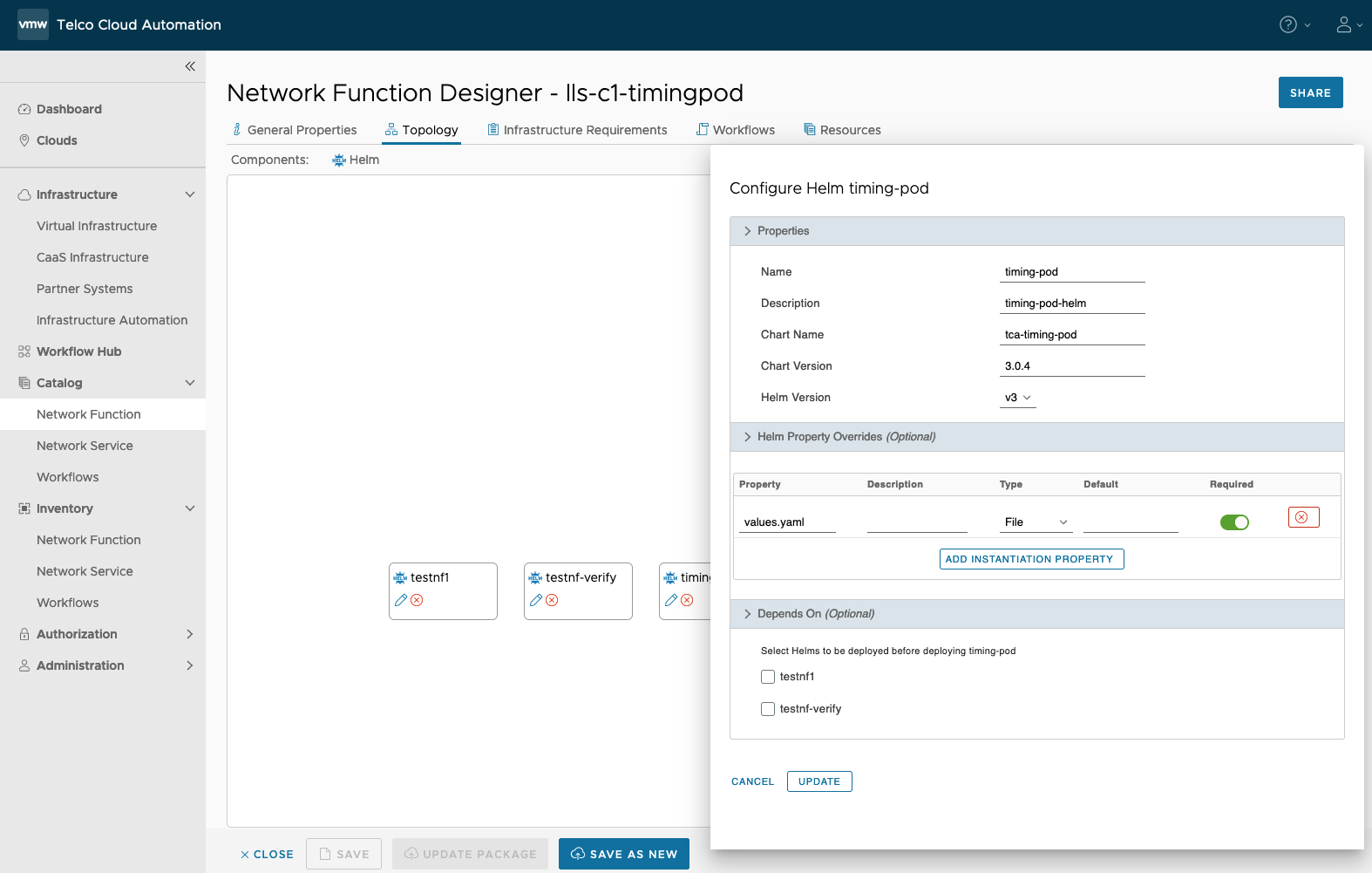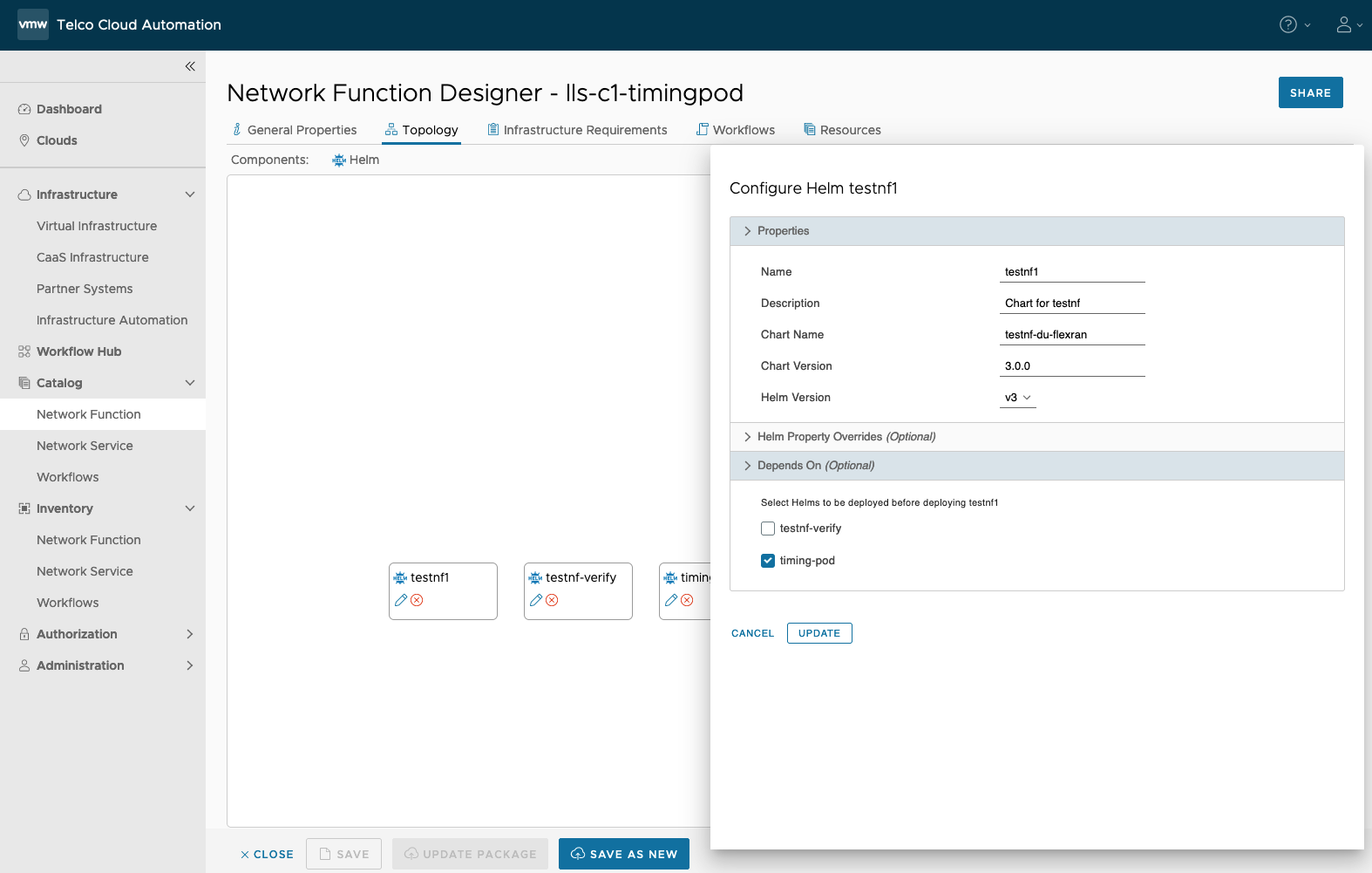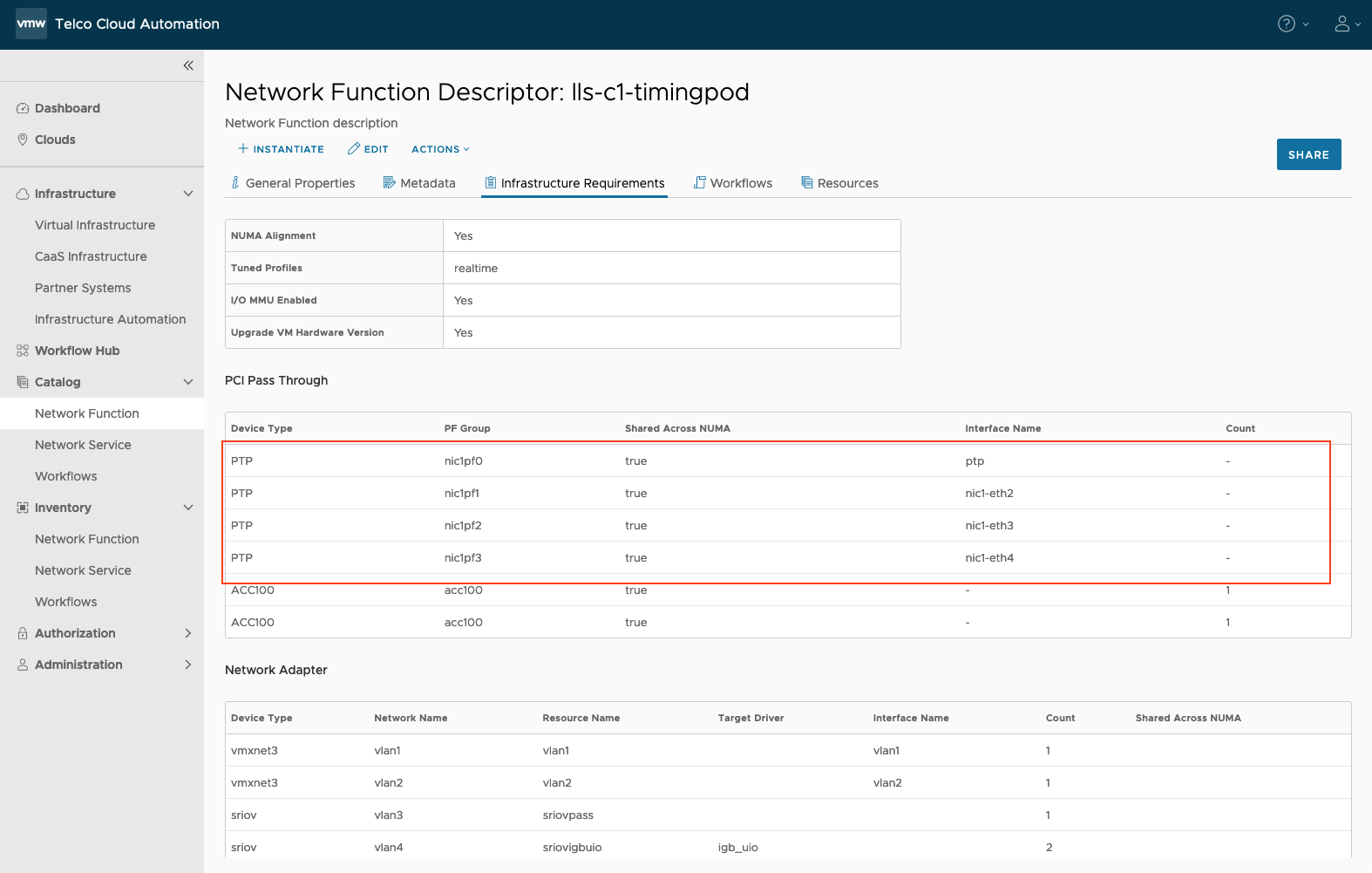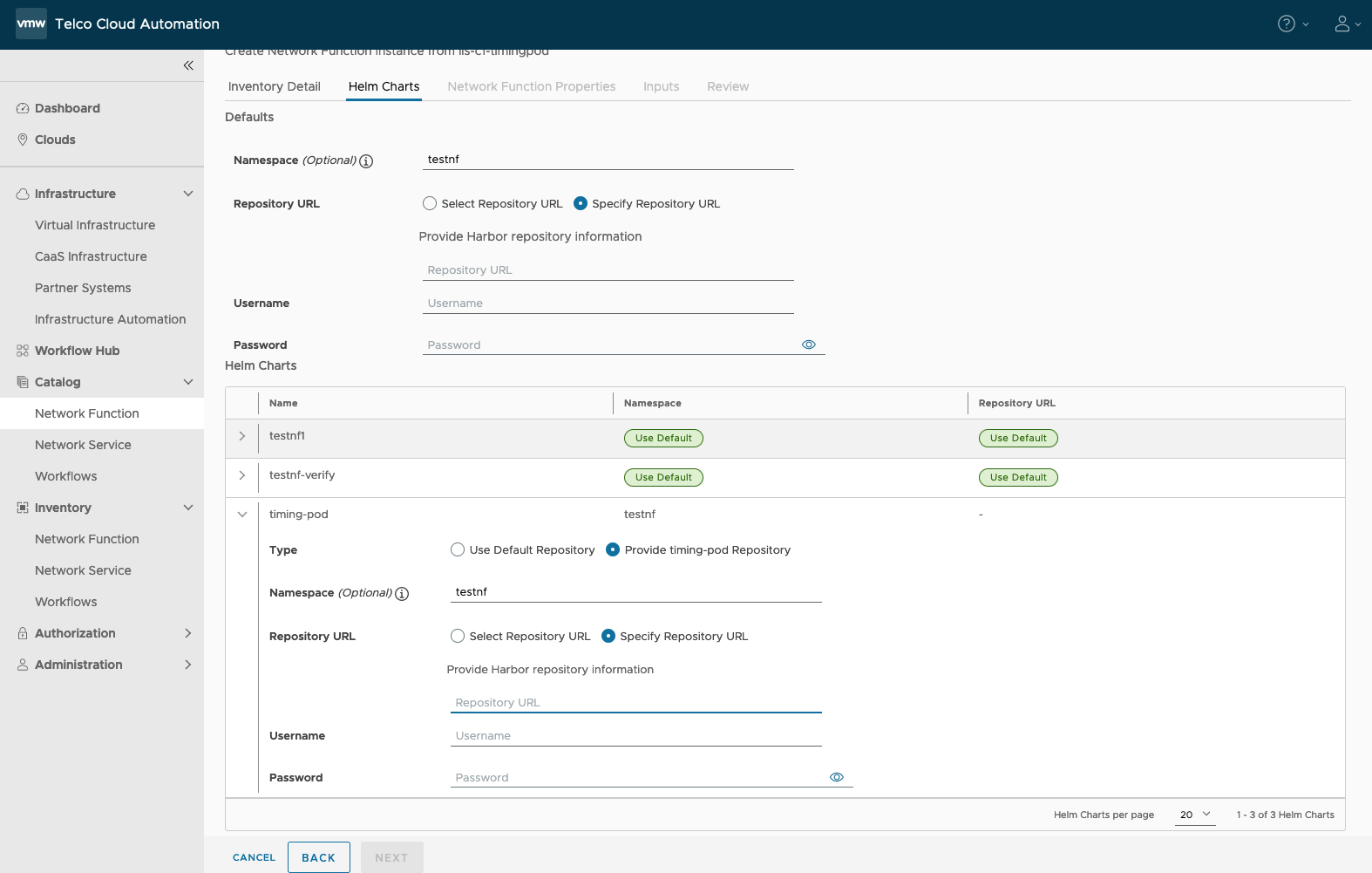This section describes how to configure a network function in LLS-C1 T-BC mode using the PTP timing pod.
VMware PTP Timing Pod is published in the form of Helm Charts. You need to modify network function CSAR and add the Timing Pod Helm as a prerequisite to the DU/application Helm Chart.
Prerequisites
Create and Apply a Host Profile to a Cell Site Group.
Note:While creating the host profile, add a dedicated PCI Group for each vmnic you want to use for PTP (Server and Client).
Procedure
- Navigate to Catalog > Network Function in the Telco Cloud Automation UI.
- Select the Network Function you want to set up in the T-BC mode and click EDIT.
- Click the Topology tab.
- Select and drag 'Helm' from Components to the workspace.
- In the Configure Help timing-pod dialog, enter all the required details about the PTP Timing Pod:
- Properties:
Name: Name of the helm chart
Description: Description of the helm chart
Chart Name: Chart name of the VMware PTP Timing Pod
Chart Version: Chart version of the VMware PTP Timing Pod.
Helm Version: Helm version.

- Helm Property Override: Add an entry for values.yaml file.
Property: values.yaml
Type: File
- Depends On (Optional): Select the timing pod helm chart and add it as a dependency to your DU Helm chart.

- Click UPDATE to save the changes.
- Properties:
- Click the Infrastructure Requirements tab and add the PTP devices.
- Add a PTP device for each port that is connected to RU and PTP GM.

- Save the Network Function.
- Add a PTP device for each port that is connected to RU and PTP GM.
- Instantiate Network function CSAR.

Namespace for tca-timing-pod helm: For tca-timing-pod helm charts, do not use 'tca-system' namespace. Use the same namespace where the DU application is installed.
In the above screenshot, 'testnf' namespace is used for both the DU application and tca-timing-pod.
values.yaml for tca-timing-pod:
Use 'tca-system' as namespace in the tca-timing-pod values.yaml
Use '2' as the ProfileId for Telco Boundary Clock Mode
Example: values.yaml for tca-timing-pod for T-BC Mode
ProfileId: "2" # 1: T-TSC, 2: T-BC, 3: T-GM, 4: Dual WPC namespace: tca-system nodeSelector: { key: value } Containers: TimingController: name: timing-controller image: sebu-tcp-ran-docker-local.artifactory.eng.vmware.com/tca-timing-controller:3.0.7 resources: requests: memory: "256Mi" cpu: "1" limits: memory: "256Mi" cpu: "1" MessageQueue: name: rabbitmq image: vmwaresaas.jfrog.io/registry/rabbitmq:3.12-management resources: requests: memory: "512Mi" cpu: "500m" limits: memory: "512Mi" cpu: "500m" Monitor: name: monitor image: sebu-tcp-ran-docker-local.artifactory.eng.vmware.com/ptp-ocloud-notifications-monitor:3.0.7 resources: requests: memory: "256Mi" cpu: "500m" limits: memory: "256Mi" cpu: "500m" holdoverPeriod: 120 pollFrequency: 1 ptpSimulated: False # ptp4l config for NIC running in T-BC mode Ptp4lNic1GmConf: | [global] # # Default Data Set # twoStepFlag 1 clientOnly 0 socket_priority 0 priority1 128 priority2 128 domainNumber 24 utc_offset 37 clockClass 248 clockAccuracy 0x21 offsetScaledLogVariance 0xFFFF free_running 0 freq_est_interval 1 dscp_event 0 dscp_general 0 dataset_comparison G.8275.x G.8275.defaultDS.localPriority 128 maxStepsRemoved 255 # # Port Data Set # logAnnounceInterval -3 logSyncInterval -4 operLogSyncInterval 0 logMinDelayReqInterval -4 logMinPdelayReqInterval 0 operLogPdelayReqInterval 0 announceReceiptTimeout 3 syncReceiptTimeout 0 delayAsymmetry 0 fault_reset_interval 4 neighborPropDelayThresh 20000000 serverOnly 0 G.8275.portDS.localPriority 128 asCapable auto BMCA ptp inhibit_announce 0 inhibit_delay_req 0 ignore_source_id 0 # # Run time options # assume_two_step 0 logging_level 6 path_trace_enabled 0 follow_up_info 0 hybrid_e2e 0 inhibit_multicast_service 0 net_sync_monitor 0 tc_spanning_tree 0 tx_timestamp_timeout 300 unicast_listen 0 unicast_master_table 0 unicast_req_duration 3600 use_syslog 1 verbose 0 summary_interval 0 kernel_leap 1 check_fup_sync 0 # # Servo Options # pi_proportional_const 0.0 pi_integral_const 0.0 pi_proportional_scale 0.0 pi_proportional_exponent -0.3 pi_proportional_norm_max 0.7 pi_integral_scale 0.0 pi_integral_exponent 0.4 pi_integral_norm_max 0.3 step_threshold 0.0 first_step_threshold 0.00002 max_frequency 900000000 clock_servo pi sanity_freq_limit 200000000 ntpshm_segment 0 msg_interval_request 0 servo_num_offset_values 10 servo_offset_threshold 0 write_phase_mode 0 # # Transport options # transportSpecific 0x0 ptp_dst_mac 01:1B:19:00:00:00 p2p_dst_mac 01:80:C2:00:00:0E udp_ttl 1 udp6_scope 0x0E uds_address /var/run/ptp4l_nic1 uds_ro_address /var/run/ptp4lro_nic1 # # Default interface options # clock_type BC network_transport L2 delay_mechanism E2E time_stamping hardware tsproc_mode filter delay_filter moving_median delay_filter_length 10 egressLatency 0 ingressLatency 0 boundary_clock_jbod 1 # # Clock description # productDescription ;; revisionData ;; manufacturerIdentity 00:00:00 userDescription ; timeSource 0x20 # Name of the interface which is getting # PTP packets from the network. [nic1-eth3] serverOnly 0 # interface's connected to RUs [ptp] serverOnly 1 [nic1-eth2] serverOnly 1 Phc2sysOpts: | -s ptp -c CLOCK_REALTIME -O -37 -m -R 16 -u 16